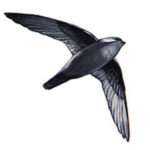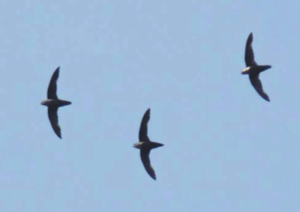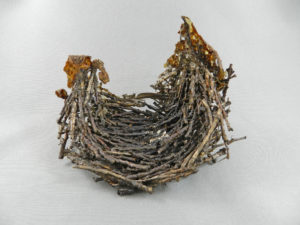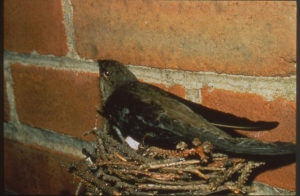 mney Swift, Chaetura pelagica, is a small, very agile, swallow-like, sooty- colored bird with long pointed wings. They look like a “flying cigar” with a short tail tipped with spines. You often hear their pleasing chippering sound before you see them. Click to see and hear Chimney Swifts (on YouTube courtesy of the Driftwood Wildlife Association).
mney Swift, Chaetura pelagica, is a small, very agile, swallow-like, sooty- colored bird with long pointed wings. They look like a “flying cigar” with a short tail tipped with spines. You often hear their pleasing chippering sound before you see them. Click to see and hear Chimney Swifts (on YouTube courtesy of the Driftwood Wildlife Association).Chimney Swifts feed exclusively on insects caught while in flight. Our Manitoba swifts arrive in mid May. Using their own sticky saliva and t wigs, adults construct a cup-shaped nest well down inside pre-1960’s era brick chimneys. The female then lays from 2 to 7 eggs which hatch in 18-21 days. The young fledge when they are 30 days old. Departing by late August, they winter in Peru, South America. They are the only species of swift that breed in eastern North America as far west as Manitoba.
wigs, adults construct a cup-shaped nest well down inside pre-1960’s era brick chimneys. The female then lays from 2 to 7 eggs which hatch in 18-21 days. The young fledge when they are 30 days old. Departing by late August, they winter in Peru, South America. They are the only species of swift that breed in eastern North America as far west as Manitoba.
The Committee on the Status of Endangered Wildlife in Canada (COSEWIC) has listed the Chimney Swift as a threatened species, and it is now listed on Schedule 1 of the Species at Risk Act. The Chimney Swift is also listed as a Threatened Species under the Manitoba Endangered Species Act.
MCSI Factsheets about Chimney Swifts:
Factsheet #1: ‘Chimney Swift: Manitoba’s Flying Cigar’. This describes the ecology, life-cycle, Manitoban range and conservation of the Chimney Swift. Version française
Factsheet #2: ‘Are Chimney Swifts Using My Chimney?’ A pertinent question! Descriptions and illustrations tell home and business owners how they might discover if their chimney is a home for Chimney Swifts. Version française
Chimney Swifts return to Manitoba around mid-May for the breeding season. They construct their nests in a dark, sheltered place, such as chimneys, barns, hollow trees, etc. The nest is built of twigs cemented together with saliva. They usually lay 4-5 white eggs (range 2 – 7) , incubated by both sexes for as little as 16, but usually for 18 to 21, days. The young are altricial (naked and helpless at hatching), and tended by both parents. The young are brooded, or warmed, after feedings for 6 -7 days as they develop the ability to regulate their body temperature; then the young are non-brooded and both parents may leave the nest site at the same time to feed. Juveniles They open their eyes at 14 days, move out of the nest to the chimney wall at 20-21 days, practice flying skills inside the chimney until fledging – the first flight outside of the chimney – between 28 – 30 days of age.
A Nest in Your Chimney

Chimney Swifts build distinctive nests by using their sticky saliva to glue short pieces of small diameter twigs together. While flying, adults use their feet to break off dead twig ends from nearby trees. The twigs are transferred to the bird’s beaks. Chimney Swifts then enter a chimney and fasten the twigs onto the rough, vertical surface to form a small cup-shaped nest.
Nests are located far below a chimney rim for protection from the sun and rain. One nest in St. Adolphe’s Club Amical (2007) was approximately 10′ down from the top of the chimney.
If it is safe and convenient to stand on your roof, you can peer down your chimney after the breeding season ends in mid- to late August. Or, you could inspect your chimney before the Chimney Swifts arrive in mid- to late May. Do not disturb nesting birds once they are active in the chimney.

(courtesy South Carolina Dept. of Natural Resources
Nests eventually fall down from the chimney wall and small twigs may have dropped during the early stages of construction. Open your chimney clean out trap to see if any nesting material is present – twigs will appear to be bonded with dried, yellowy glue; there will be no mud present. Broken pieces of small white egg shells and long, tapered, dark feathers moulted by adults are also indicators of nesting Chimney Swifts.
If you find nesting material, be assured that there is no fire hazard. As a nest would fit easily in the palm of your hand, air can circulate in the chimney properly during the heating season.
 Nature Manitoba is pleased to be involved in this project to better understand the causes behind Chimney Swift population declines and hopefully reverse this trend.
Nature Manitoba is pleased to be involved in this project to better understand the causes behind Chimney Swift population declines and hopefully reverse this trend.For more information:
Our project coordinator may be contacted at mbchimneyswift@gmail.com or by phoning the Nature Manitoba office at 204 943-9029
